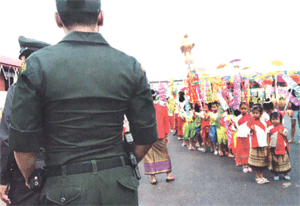
| By LAWI WENG | APRIL, 2008 - VOLUME 16 NO.4 |
The Mon, one of the earliest indigenous people in the Thai-Burmese area, were instrumental in disseminating Buddhism to the region. Nowadays they face a fight for cultural survival
CONCENTRATED in the mountainous border area of Burma and Thailand, up to three million Mon are struggling to preserve their culture and language.
Researchers and anthropologists worry that Mon culture may disappear entirely, deliberately assimilated through the policies of both the Thai and Burmese governments.
 |
| Thai military officials observe a Mon festival in Samut Sakhon near Bangkok. (Photo: Bangkok Post) |
In Thailand, meanwhile, security officials pressured organizers of the annual Mon National Day festival in February to refrain from singing and dancing, to limit the festival to one day, to identify the organizers of the festival and ban the participation of unregistered workers from Burma.
In addition, Thai officials also urged the public not to support the Mon cultural events at Samut Sakhorn, home to almost 200,000 workers from Burma, the majority of whom are Mon.
Nai Santhorn, the chairman of the Mon Cultural Center (MCC), based in Sangkhlaburi, a small town in western Thailand that hosts the country’s largest Mon community, said: “We feel that our way of life is being threatened.”
Mon people have been practicing Theravada Buddhism for longer than any other community in the world except for the Sinhalese of Sri Lanka. They were the first group to accept the teachings of the Buddha in Thailand and Burma; the religion now predominates throughout Southeast Asia.
Historically, the Mon were the first people in present-day Thailand and Lower Burma to create a city state. In the 8th and 9th century the Mon founded the Dvaravati kingdom in Hariphunchai, now called Lamphun, some 25 kilometers south of Chiang Mai in northern Thailand.
The “Golden Age” of Mon rule began when a Mon dynasty assumed power in Lower Burma after the Pagan Empire fell to the Mongols in 1287, around the same time as the Mon were driven out of Hariphunchai by the Thais. The capital of the new Mon kingdom was originally Martaban, though it soon relocated to Pegu.
During the reign of King Rajadhirat (1383-1421), the Burmese kingdom of Ava and the Mon kingdom of Pegu were engaged in continuous warfare. The peaceful reign (1453-72) of Queen Baña Thau (in Burmese: Shin Saw Bu) came to an end when she nominated the Buddhist monk, Dhammazedi, to succeed her. Under Dhammazedi (1472-92), Pegu became a center of commerce and Theravada Buddhism.
From 1369-1539, Pegu, known then as Hongsawadee, was the capital of the Mon Kingdom of Ramanadesa, which covered all of what is now lower Burma. The area returned to Burman control in 1539 when it was annexed by King Tabinshweti into the Kingdom of Taungoo.
The kings of Taungoo made Pegu the royal capital from 1539-99 and again from 1613-34, employing it as a base for repeated invasions of Siam.
In 1740, the Mon revolted and briefly regained independence, but the Burmese King Alaungpaya sacked the city and ended Mon independence in 1757.
The Mon people keep their national pride alive by annually commemorating the date of the foundation of the Mon kingdom.
Until this year, the Mon in Thailand and Burma traditionally held a two to three-day festival to mark Mon National Day. In February, however, the new governor of Samut Sakhorn Province imposed severe restrictions on the festival. On February 3, Thai police blocked entry into the Ban Rai Charoenpol temple in Samut Sakhorn, where the celebration was slated to take place.
According to the English language daily Bangkok Post, Thailand’s Internal Security Operations Command issued prior notice that the festival was prohibited from staging activities that encouraged “national sentiment.”
Mon cultural rights groups say that the restrictions are based on a misunderstanding; the MCC chairman said he hopes the governor will come to understand the difference between cultural expression and political activism.
“The festival was just supposed to be an opportunity to donate food to the monks and commemorate Mon leaders,” Nai Santhorn told The Irrawaddy. “It was about Mon culture. There was dancing, not talk about politics.”
In Rangoon, public observances of Mon National Day were also banned.
However, the Mon people celebrated their national day regardless. Celebrants in red and white Mon national dress gave alms to monks and prayed for famous leaders in Mon history. Hundreds of young people traveled by motorbike to the Mon State capital, Moulmein, to celebrate the 61st Mon National Day. People prayed at the historic pagodas of Kyeik Than Lan, Taung Wai and Kyeik Thout.
“We are taking this opportunity to celebrate our culture,” said a young leader of a Moulmein community of monks. “We demand our rights.”